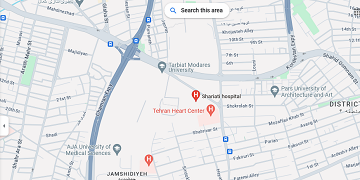- 1404/09/22 A Comprehensive Study of the Global COVID 19 Pandemic and Fungal Co Infections: A Review
- 1404/09/22 Exosome functionalized collagen coated 3D printed PCL scaffold for enhanced osteogenic differentiation and bone regeneration: an in vitro and in vivo study
- 1404/09/22 Investigating the Level of MUC5B Expression in the Plasma of Patients with Idiopathic Pulmonary Fibrosis (IPF) Compared to Healthy Individuals
- 1404/08/27 Investigation of the effect of bone marrow derived exosomes on the induction of MIR139 b expression and the role of P53 in its regulation in head and neck squamous cell carcinoma cell line
- 1404/08/27 The Comparison between the Level of Anxiety and General Quality of Life in Parents of Children with Cleft Lip and Palate With And Without Nasoalveolar Molding (NAM).
- 1404/08/27 Investigation of the Effects of Bone Marrow Derived Mesenchymal Stem Cell Extracellular Vesicles Combined with Zinc Oxide Nanoparticles on the Regulation of Gene Expression Related to Facial and Neck Skin Tissue Regeneration
- 1404/08/22 The Journal of Craniomaxillofacial Research has been accepted and indexed in Scopus
Developmental abnormalities
 Developmental abnormalities of the face and jaw are a major focus in Craniomaxillofacial Research Centers, as these conditions can affect both the appearance and function of an individual. Such abnormalities often result from genetic or environmental factors that disrupt normal facial growth during early development. Research in this area is aimed at improving the understanding, diagnosis, treatment, and correction of these congenital conditions.
Developmental abnormalities of the face and jaw are a major focus in Craniomaxillofacial Research Centers, as these conditions can affect both the appearance and function of an individual. Such abnormalities often result from genetic or environmental factors that disrupt normal facial growth during early development. Research in this area is aimed at improving the understanding, diagnosis, treatment, and correction of these congenital conditions.
Key Areas of Research on Developmental Abnormalities in Craniomaxillofacial Centers:
1. Common Developmental Abnormalities:
- Cleft Lip and Palate: One of the most common congenital abnormalities, where the lip and/or palate fail to fuse properly during fetal development. This can result in problems with feeding, speech, hearing, and dental development.
- Craniosynostosis: A condition where one or more of the cranial sutures close prematurely, affecting the shape of the skull and potentially causing brain development issues.
- **Hemifacial Microsomia**: A disorder where one side of the face is underdeveloped, often involving the ear, mouth, and jaw, leading to asymmetry.
- **Pierre Robin Sequence**: A condition characterized by a small lower jaw (micrognathia), a tongue that falls back into the throat, and airway obstruction. This can also be associated with cleft palate.
- **Treacher Collins Syndrome**: A genetic disorder that affects facial bone and tissue development, leading to deformities of the ears, eyes, cheekbones, and chin.
- **Fibrous Dysplasia**: A disorder where normal bone is replaced with fibrous tissue, leading to asymmetry and deformities in the skull and facial bones
2. Genetic Research and Molecular Biology:
- Research focuses on identifying the genetic mutations or disruptions that cause these developmental abnormalities. For example, mutations in certain genes like **FGFR**, **TCOF1**, and **MSX1** have been linked to craniosynostosis, Treacher Collins Syndrome, and cleft palate.
- **Gene Therapy and Stem Cell Research**: Scientists are investigating the potential for gene editing technologies, such as CRISPR, and stem cell therapies to correct or prevent these abnormalities at a molecular level before birth.
3. Prenatal Diagnosis and Early Intervention:
- **Ultrasound and Fetal Imaging**: Advanced imaging technologies such as 3D ultrasound and MRI allow for early detection of facial and cranial abnormalities in the womb. This helps in planning early interventions, either prenatally or immediately after birth.
- **Fetal Surgery**: Some research centers are exploring fetal surgery options, where corrective procedures are performed on the fetus before birth to improve outcomes in conditions like cleft palate or craniosynostosis.
4. Surgical Treatment and Reconstruction:
- **Craniofacial Surgery**: Research aims to improve surgical techniques for correcting developmental abnormalities of the face and skull. For example, **distraction osteogenesis** is used to lengthen bones in patients with conditions like hemifacial microsomia or micrognathia.
- **Timing of Surgery**: Research is conducted to determine the optimal timing for surgery, balancing the need for early correction with the child’s growth and development. For cleft palate, this could involve primary closure in infancy, followed by secondary surgeries as the child grows.
- **3D Planning and Custom Implants**: Advanced 3D imaging and modeling are used to plan precise surgeries. Custom implants or prosthetics may be designed using 3D printing to fit the unique needs of each patient, especially in complex reconstructions involving the skull or facial bones.
5. Orthodontics and Dentofacial Orthopedics:
- Developmental abnormalities often lead to malocclusion (misaligned teeth) and other dental issues. Research in this area focuses on advanced orthodontic techniques and devices that can guide the proper growth of the jaws and teeth.
- **Jaw Surgery (Orthognathic Surgery)**: For patients with jaw discrepancies due to developmental issues, research on orthognathic surgery looks at the best ways to correct jaw alignment, often in combination with orthodontic treatment.
6. Speech and Feeding Therapy:
- Infants with cleft palate or similar conditions may struggle with feeding due to the structural issues in the mouth. Research focuses on developing specialized feeding devices or early surgical interventions to assist with this.
- **Speech Therapy**: After surgical correction, many children require speech therapy. Research explores the best approaches for speech rehabilitation in children with developmental abnormalities affecting the mouth and jaw.
7. Bone and Tissue Engineering:
- For patients with significant bone deficiencies or missing tissues due to developmental abnormalities, research into **bone grafts**, **tissue scaffolding**, and **regenerative medicine** plays a crucial role. Techniques like stem cell-derived tissue regeneration and biocompatible scaffolds aim to replace or repair missing structures.
- **Fat Grafting and Soft Tissue Reconstruction**: Research also focuses on the best ways to restore soft tissue lost in congenital conditions, including the use of fat grafting, dermal fillers, or autologous tissue transfers.
8. Cranial Vault Expansion:
- In conditions like craniosynostosis, where the skull fails to grow normally, research centers explore techniques for cranial vault expansion to relieve pressure on the brain and allow normal brain growth. This often involves cutting and reshaping the bones of the skull, then using distraction devices to gradually expand the cranial space.
9. Psychosocial and Long-Term Outcomes:
- Developmental abnormalities can have a profound impact on a child’s self-esteem and social development. Research often includes the study of psychological support, social integration, and long-term outcomes for patients who undergo corrective surgery.
- **Patient and Family Support Programs**: Many craniomaxillofacial centers also conduct research on how to best support families dealing with developmental abnormalities, including counseling and education on the condition, treatment options, and what to expect in the long term.
10. Advances in Minimally Invasive Surgery:
- Minimally invasive surgical techniques, such as endoscopic approaches for treating craniosynostosis or small-incision procedures for cleft repairs, are researched to reduce recovery times, minimize scarring, and improve functional outcomes.
Multidisciplinary Approach
The treatment and research on developmental abnormalities in craniomaxillofacial centers often involve a team of specialists including plastic and maxillofacial surgeons, orthodontists, geneticists, speech therapists, and psychologists. This **multidisciplinary approach** is essential for ensuring that all aspects of the condition—functional, aesthetic, and psychological—are addressed for the best patient outcomes.
Research in this area continues to push the boundaries of what is possible, with the goal of improving both **functional outcomes** and **aesthetic results** for children and adults born with craniofacial developmental abnormalities.


